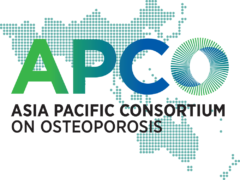The APCO Framework
PURPOSE OF THE FRAMEWORK
Anecdotal evidence to date demonstrates significant disparity in osteoporosis clinical practice guidelines in the Asia Pacific region.
As its first major initiative, APCO members representing key osteoporosis stakeholders and multiple medical and surgical specialities throughout the region, developed The APCO Framework - a set of clear, concise, relevant and pragmatic clinical standards to support national societies, guidelines development authorities, and health care policy makers with the development of new guidelines, and to encourage the revision of existing guidelines, in Asia Pacific.
About the framework
The APCO Framework represents the first pan-Asia Pacific clinical practice standards for the screening, diagnosis and management of osteoporosis, targeting a broad range of high-risk groups:
Published in Osteoporosis International on Jan 27, 2021, ‘The APCO Framework’ comprises 16 minimum clinical standards that serve as a benchmark for the provision of optimal osteoporosis care in the Asia Pacific region.
Implementation of the minimum clinical standards proposed by The APCO Framework, and reform of existing guidelines, will support clinical improvement initiatives, while also helping to pave the way for a more holistic approach to osteoporosis care, and ultimately, greater consistency across all national and regional clinical practice guidelines in the region.
Development of The APCO Framework
APCO employed a 5IQ analysis to evaluate clinical practice guidelines currently available in Asia Pacific. A subsequent comprehensive, four-round Delphi consensus method enabled APCO members to reach agreement on a benchmark set of clinical standards for the provision of quality osteoporosis care for the Asia Pacific region.
To develop the Framework, APCO;1
-
Conducted a systematic, structured analysis of existing guidelines in the Asia Pacific region;
-
Identified regionally relevant key guidelines elements; and
-
Using a structured consensus process, developed feasible regional clinical care standards designed to support clinical improvement initiatives, and to provide a framework for adaptation and adoption throughout the region.
The 5IQ model used for analysing the content of the clinical practice guidelines accounted for the following:2
Identification
A statement of which individuals should be identified
Investigation
A description of the type of investigations to be undertaken
Information
A description of the type of information to be provided to an individual
Intervention
A description of pharmacological interventions and falls prevention
Integration
A statement on the need for integration between primary and secondary care
Quality
A description of professional development, audit and peer-review activities
From each guideline, information was gathered on case identification, investigations, patient advice and education, interventions, strategies for long-term management and integration of osteoporosis into health systems, strategies to promote the delivery of quality clinical care, and other background data.
The 5IQ exercise assessed the extent of consensus or discord when comparing the national guidelines currently available throughout the Asia Pacific region.
The Framework was informed by similar initiatives developed by the International Osteoporosis Foundation (IOF) and European Society for Clinical and Economic Aspects of Osteoporosis (ESCEO).
The Delphi technique (a structured communication technique using a systematic, interactive forecasting method reliant upon an expert panel) was employed to achieve APCO member consensus for the development of clinical standards of care.3
Development of The APCO Framework offers APCO members the opportunity to invite their clinical peers to perform ‘pathfinder baseline audits’ of adherence to the Framework’s standards of care within their respective hospitals, enabling the establishment of baseline levels of adherence within the standards proposed by the Framework, region-wide.
Pathfinder audits
APCO members could also utilise their pathfinder audit results to encourage their respective national guidelines development groups to incorporate the standards of care advocated in the Framework, into new or revised national osteoporosis guidelines.3
-
Chandran, M., Mitchell, P.J., Amphansap, T. et al. Development of the Asia Pacific Consortium on Osteoporosis (APCO) Framework: clinical standards of care for the screening, diagnosis, and management of osteoporosis in the Asia-Pacific region. Osteoporos Int (2021). https://doi.org/10.1007/s00198-020-05742-0
-
National Osteoporosis Society. Effective Secondary Prevention of Fragility Fractures: Clinical Standards for Fracture Liaison Services. [cited Jan, 2020]; Available from: https://theros.org.uk/media/2082/clinical-standards-for- fracture-liaison-services.pdf.
-
Royal College of Obstetricians and Gynaecologists. The Delphi technique. 2005. [cited Jan, 2020]; Available from: https://obgyn.onlinelibrary.wiley.com/doi/pdf/10.1576/toag.7.2.120.27071.
